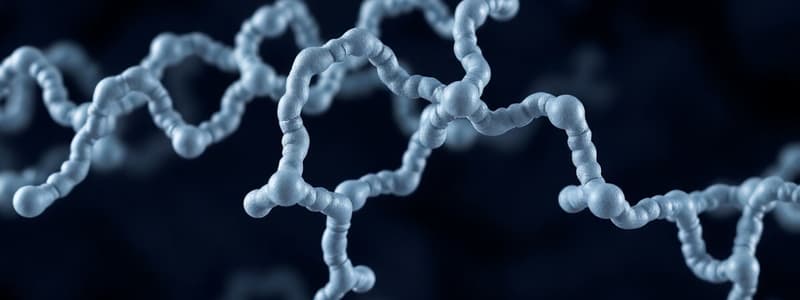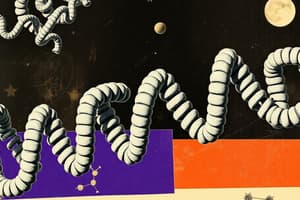Podcast
Questions and Answers
Which of the following is NOT a function of proteins?
Which of the following is NOT a function of proteins?
- Catalysis
- Transport
- Signalling
- Energy storage (correct)
Amino acids consist of a central carbon atom, an amino group, and only one functional group.
Amino acids consist of a central carbon atom, an amino group, and only one functional group.
False (B)
What are the four structures in proteins that can be recognized?
What are the four structures in proteins that can be recognized?
Primary, secondary, tertiary, and quaternary structures
Proteins that increase the reaction rate of metabolic reactions are known as ______.
Proteins that increase the reaction rate of metabolic reactions are known as ______.
Match the following protein functions with their descriptions:
Match the following protein functions with their descriptions:
Which part of the amino acid structure varies among different amino acids?
Which part of the amino acid structure varies among different amino acids?
There are fewer than 300 amino acids that can be found in nature.
There are fewer than 300 amino acids that can be found in nature.
What is the primary role of hemoglobin in the body?
What is the primary role of hemoglobin in the body?
What type of bond is formed between two cysteine amino acids?
What type of bond is formed between two cysteine amino acids?
Denaturation results in a change in the primary structure of proteins.
Denaturation results in a change in the primary structure of proteins.
What is the term for the loss of biological activity in proteins without a change in primary structure?
What is the term for the loss of biological activity in proteins without a change in primary structure?
The ___ structure of proteins involves local hydrogen bonds between amino acids.
The ___ structure of proteins involves local hydrogen bonds between amino acids.
How many amino acids are primarily coded by DNA for protein synthesis?
How many amino acids are primarily coded by DNA for protein synthesis?
Match the types of protein structure to their definitions:
Match the types of protein structure to their definitions:
Selenocysteine is considered the 21st amino acid in eukaryotes.
Selenocysteine is considered the 21st amino acid in eukaryotes.
Which of the following processes involves gaining natural form after denaturation?
Which of the following processes involves gaining natural form after denaturation?
What conformation are amino acids in protein structures always found?
What conformation are amino acids in protein structures always found?
Hydrophobic amino acids are found on the surface of proteins in aqueous media.
Hydrophobic amino acids are found on the surface of proteins in aqueous media.
Essential amino acids cannot be synthesized in __________ and must be obtained from the diet.
Essential amino acids cannot be synthesized in __________ and must be obtained from the diet.
Match the following terms with their descriptions:
Match the following terms with their descriptions:
During peptide bond formation, one molecule of ___ is released.
During peptide bond formation, one molecule of ___ is released.
Which of the following statements is true regarding amino acids?
Which of the following statements is true regarding amino acids?
Asidic environment corresponds to a high pH.
Asidic environment corresponds to a high pH.
What happens to an amino acid when a phosphate group is added?
What happens to an amino acid when a phosphate group is added?
Flashcards
Protein Functions
Protein Functions
Proteins play vital roles in biological processes, including catalysis (enzyme function), transport, signaling, and structural support.
Amino Acid Structure
Amino Acid Structure
Amino acids have a central carbon atom (alpha carbon) bonded to an amino group (-NH2), a carboxyl group (-COOH), and a side chain (radical group).
Protein Catalysis
Protein Catalysis
Proteins act as enzymes to speed up chemical reactions in the body by lowering the activation energy.
Protein Transport
Protein Transport
Signup and view all the flashcards
Protein Signaling
Protein Signaling
Signup and view all the flashcards
Protein Structure: Primary
Protein Structure: Primary
Signup and view all the flashcards
Protein Structure: Secondary
Protein Structure: Secondary
Signup and view all the flashcards
Protein Structure: Amino Acids
Protein Structure: Amino Acids
Signup and view all the flashcards
Peptide Bond Formation
Peptide Bond Formation
Signup and view all the flashcards
Secondary Structure
Secondary Structure
Signup and view all the flashcards
Tertiary Structure
Tertiary Structure
Signup and view all the flashcards
Hydrophobic Interactions
Hydrophobic Interactions
Signup and view all the flashcards
Disulfide Bonds
Disulfide Bonds
Signup and view all the flashcards
Quaternary Structure
Quaternary Structure
Signup and view all the flashcards
Denaturation
Denaturation
Signup and view all the flashcards
Renaturation
Renaturation
Signup and view all the flashcards
Proteinogenic amino acids
Proteinogenic amino acids
Signup and view all the flashcards
Selenocysteine
Selenocysteine
Signup and view all the flashcards
L- amino acids in protein
L- amino acids in protein
Signup and view all the flashcards
Essential amino acids
Essential amino acids
Signup and view all the flashcards
Amino acid abbreviation
Amino acid abbreviation
Signup and view all the flashcards
Amino Acids and pH
Amino Acids and pH
Signup and view all the flashcards
Isoelectric point
Isoelectric point
Signup and view all the flashcards
Primary Structure of Protein
Primary Structure of Protein
Signup and view all the flashcards
Study Notes
Amino Acids and Protein Structure
- Proteins are biomacromolecules composed of amino acids.
- Proteins have diverse functions, including catalysis, transport, signaling, and structural support.
- Learning objectives include listing protein functions, describing amino acid structure, calculating isoelectric points, and recognizing protein structures.
Learning Objectives
- List the functions of proteins.
- Describe the structure of amino acids.
- Calculate isoelectric points.
- Describe the bonds forming proteins.
- Recognize primary, secondary, tertiary, and quaternary structures in proteins.
- Explain protein denaturation.
Proteins
- Proteins are responsible for various important duties.
- They are biomacromolecules made of amino acids.
DNA, RNA, and Protein
- DNA → RNA → Protein
- DNA replication, transcription, and translation are crucial processes.
Protein Functions - Catalysis
- Enzymes increase reaction rates by lowering activation energy.
- Maltose to Glucose in 1 sec, normally it's 300 years.
Protein Functions - Transport
- Proteins transport substances in the circulatory system and between cellular compartments.
- Examples include hemoglobin and lipoproteins.
Protein Functions - Signaling
- Proteins act as hormones, directing and regulating metabolism.
- Receptors receive signals and play vital roles in cellular responses.
Protein Functions - Structural Elements
- Proteins form cytoskeletal elements, muscles, hair, and nails, providing essential structural support.
- Some proteins are solely structural.
Protein Structure
- RNA creates 3D structures.
Amino Acids
- Amino acids have different shapes.
- There are more than 300 amino acids in nature but only 20 are constituents of proteins.
- Some amino acids have special roles, like selenocysteine in eukaryotes.
- Amino acids have a central carbon atom, a carboxyl group, an amino group, and a variable side chain (radical). This side-chain gives it various properties.
- They can be positive, negative, or neutral. The side chains' properties determine how the amino acid interacts with water and other molecules.
Amino Acids - 21st Amino Acid
- In eukaryotes, selenocysteine (21st) is also used.
L- and D- Isomers
- Amino acids in proteins are L-isomers.
- They exist as mirror-image isomers.
Amino Acids - Acidic Side Chains
- Aspartic and glutamic acids.
Amino Acids - Basic Side Chains
- Lysine, arginine, and histidine.
Amino Acids - Polar Uncharged Side Chains
- Serine, threonine, asparagine, glutamine, cysteine, glycine, proline.
Amino Acids - Hydrophobic Side Chains
- Alanine, isoleucine, leucine, methionine, phenylalanine, tryptophan, tyrosine, valine.
Amino Acids and pH
- Amino acids are amphoteric molecules.
- They have both acidic and basic properties.
- The net charge of an amino acid depends on pH.
- Isoelectric point (pI) is the pH where the net charge is zero.
Primary Structure
- Consists of the amino acid sequence arranged in a linear chain.
- Peptide bonds connect amino acids.
Secondary Structure
- Local hydrogen bonds between amino acids result in structures like alpha-helices and beta-sheets.
Tertiary Structure
- Interactions between amino acids form a compact 3D structure with interactions from hydrophobic/hydrophilic amino acids.
- Numerous interactions maintain the shape: disulfide bridges, hydrogen bonds, ionic bonds, and hydrophobic interactions.
Quaternary Structure
- Multiple polypeptide chains form a larger structure, such as in hemoglobin. Also determined by interactions of R groups.
Denaturation
- Denaturation is the loss of protein's 3D structure. This leads to a loss of biological activity.
- Caused by factors such as temperature, pH, organic solvents, heavy metals, and detergents.
Renaturation
- Protein's regaining its natural form after denaturation is called renaturation.
- It depends on specific conditions.
Studying That Suits You
Use AI to generate personalized quizzes and flashcards to suit your learning preferences.




